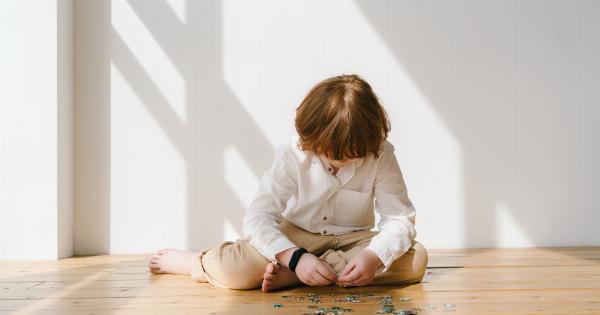As parents, we are often in tune with our child’s needs and well-being. However, there may be times when we notice that something seems off with our child’s behavior or reactions to certain stimuli.
One possibility to consider is whether your child is experiencing sensory overload.
What is Sensory Overload?
Sensory overload is a condition in which the sensory stimuli from the environment become overwhelming for an individual.
This can occur when there is an excessive amount of sensory information or when the brain has difficulty processing and integrating the sensory input.
The Symptoms of Sensory Overload
Each child may experience sensory overload differently, but there are common symptoms to watch out for. These include:.
- Hypersensitivity: Your child may be highly sensitive to certain stimuli such as loud noises, bright lights, or strong smells.
- Extreme reactions: Your child may have intense reactions to sensory information, such as covering their ears or closing their eyes when exposed to certain sounds or lights.
- Difficulty concentrating: Sensory overload can make it challenging for a child to focus and pay attention, particularly in stimulating environments.
- Overwhelmed or anxious: Your child may become easily overwhelmed or anxious in situations that involve a lot of sensory input, such as crowded places or busy events.
- Difficulty with transitions: Changes in routine or transitioning from one activity to another may be difficult for a child experiencing sensory overload.
- Withdrawal or avoidance: Some children may withdraw or avoid certain environments or activities that trigger sensory overload.
The Causes of Sensory Overload
There are several potential causes of sensory overload in children, including:.
- Sensory processing disorder (SPD): SPD is a condition in which the brain has difficulty receiving and responding to sensory information. This can lead to overreacting or underreacting to certain stimuli.
- Autism spectrum disorder (ASD): Many children on the autism spectrum experience sensory overload due to their heightened sensitivity to sensory input.
- Anxiety: Children with anxiety disorders may be more prone to sensory overload as they are more sensitive to their surroundings.
- Hyperactivity: Children with ADHD or hyperactivity may struggle to filter out irrelevant sensory information, leading to overload.
Managing Sensory Overload in Children
If you suspect that your child is experiencing sensory overload, there are strategies and techniques that can help:.
- Identify triggers: Pay attention to the specific stimuli that seem to trigger sensory overload in your child. This can help you create a plan to minimize exposure or prepare your child for those situations.
- Create a sensory-friendly environment: Make adjustments at home or in school to create an environment that is more accommodating for your child’s sensory needs. This may involve using noise-cancelling headphones, dimming lights, or providing a designated quiet space.
- Use sensory tools and techniques: Occupational therapists often recommend sensory tools and techniques to help children manage sensory overload. These may include fidget toys, weighted blankets, or deep pressure activities.
- Provide a predictable routine: Establishing a predictable routine can help children with sensory overload feel more secure and prepared for what to expect.
- Practice relaxation techniques: Teach your child simple relaxation techniques, such as deep breathing or mindfulness exercises, to help them calm down during overwhelming situations.
- Seek professional help if needed: If your child’s sensory overload significantly interferes with their daily life or causes distress, it may be beneficial to consult with a healthcare professional or occupational therapist.
The Importance of Understanding Sensory Overload
Recognizing and understanding sensory overload in children is crucial. By identifying the triggers and implementing effective strategies, parents and caregivers can support their child’s sensory needs and help them thrive in various environments.
Conclusion
Sensory overload is a real and challenging condition that many children face. By being observant and proactive, parents can make a significant difference in mitigating the impact of sensory overload on their child’s daily life.
Remember, each child is unique, and what works for one may not work for another. Patience, compassion, and seeking appropriate support are essential in helping your child navigate the world while managing sensory overload.



























